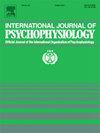HRV modulates dorsomedial prefrontal cortex activity during emotionally enhanced memory-guided attention in a visual search task
IF 2.6
3区 心理学
Q3 NEUROSCIENCES
引用次数: 0
Abstract
Emotion, memory, and attention are closely interconnected, guiding cognitive processes and behavior. However, whether and how this complex interplay is modulated by the autonomic nervous system has been largely neglected to date. This study used functional MRI (fMRI) to investigate the relationship between heart rate variability (HRV) and brain function in healthy adults during an emotionally enhanced memory-guided visual search task. Participants engaged in a two-phase paradigm: during the encoding phase, they memorized the locations of targets embedded in emotional (positive or negative) or neutral images; during the retrieval phase, they identified low-contrast targets in previously viewed or novel images. High-frequency HRV (HF-HRV) was recorded at rest in the scanner during the anatomical image acquisition and subsequently correlated with the brain activation map derived from the interaction contrast of target memory and emotional context. Results revealed a positive correlation between HF-HRV and activation of the dorsomedial prefrontal cortex (dmPFC), a region implicated in emotional regulation and higher-order cognitive processes. These findings highlight the potential capacity of HRV to reflect the dmPFC's integration of emotional and cognitive processes to optimize memory-guided visual search performance.
在视觉搜索任务中,在情绪增强的记忆引导注意过程中,HRV调节背内侧前额叶皮层的活动。
情感、记忆和注意力紧密相连,指导着认知过程和行为。然而,这种复杂的相互作用是否以及如何由自主神经系统调节,迄今为止在很大程度上被忽视。本研究使用功能磁共振成像(fMRI)研究了健康成人在情绪增强记忆引导的视觉搜索任务中心率变异性(HRV)与脑功能之间的关系。参与者参与了两阶段范式:在编码阶段,他们记忆嵌入情绪(积极或消极)或中性图像中的目标位置;在检索阶段,他们在以前看过的或新的图像中识别出低对比度的目标。高频HRV (HF-HRV)在解剖图像采集过程中在扫描仪中被记录下来,随后与目标记忆和情绪背景的相互作用对比得出的大脑激活图相关联。结果显示,HF-HRV与背内侧前额叶皮层(dmPFC)的激活呈正相关,该区域涉及情绪调节和高阶认知过程。这些发现强调了HRV的潜在能力,反映了dmPFC的情感和认知过程的整合,以优化记忆引导的视觉搜索性能。
本文章由计算机程序翻译,如有差异,请以英文原文为准。
求助全文
约1分钟内获得全文
求助全文
来源期刊
CiteScore
5.40
自引率
10.00%
发文量
177
审稿时长
3-8 weeks
期刊介绍:
The International Journal of Psychophysiology is the official journal of the International Organization of Psychophysiology, and provides a respected forum for the publication of high quality original contributions on all aspects of psychophysiology. The journal is interdisciplinary and aims to integrate the neurosciences and behavioral sciences. Empirical, theoretical, and review articles are encouraged in the following areas:
• Cerebral psychophysiology: including functional brain mapping and neuroimaging with Event-Related Potentials (ERPs), Positron Emission Tomography (PET), Functional Magnetic Resonance Imaging (fMRI) and Electroencephalographic studies.
• Autonomic functions: including bilateral electrodermal activity, pupillometry and blood volume changes.
• Cardiovascular Psychophysiology:including studies of blood pressure, cardiac functioning and respiration.
• Somatic psychophysiology: including muscle activity, eye movements and eye blinks.

 求助内容:
求助内容: 应助结果提醒方式:
应助结果提醒方式:


